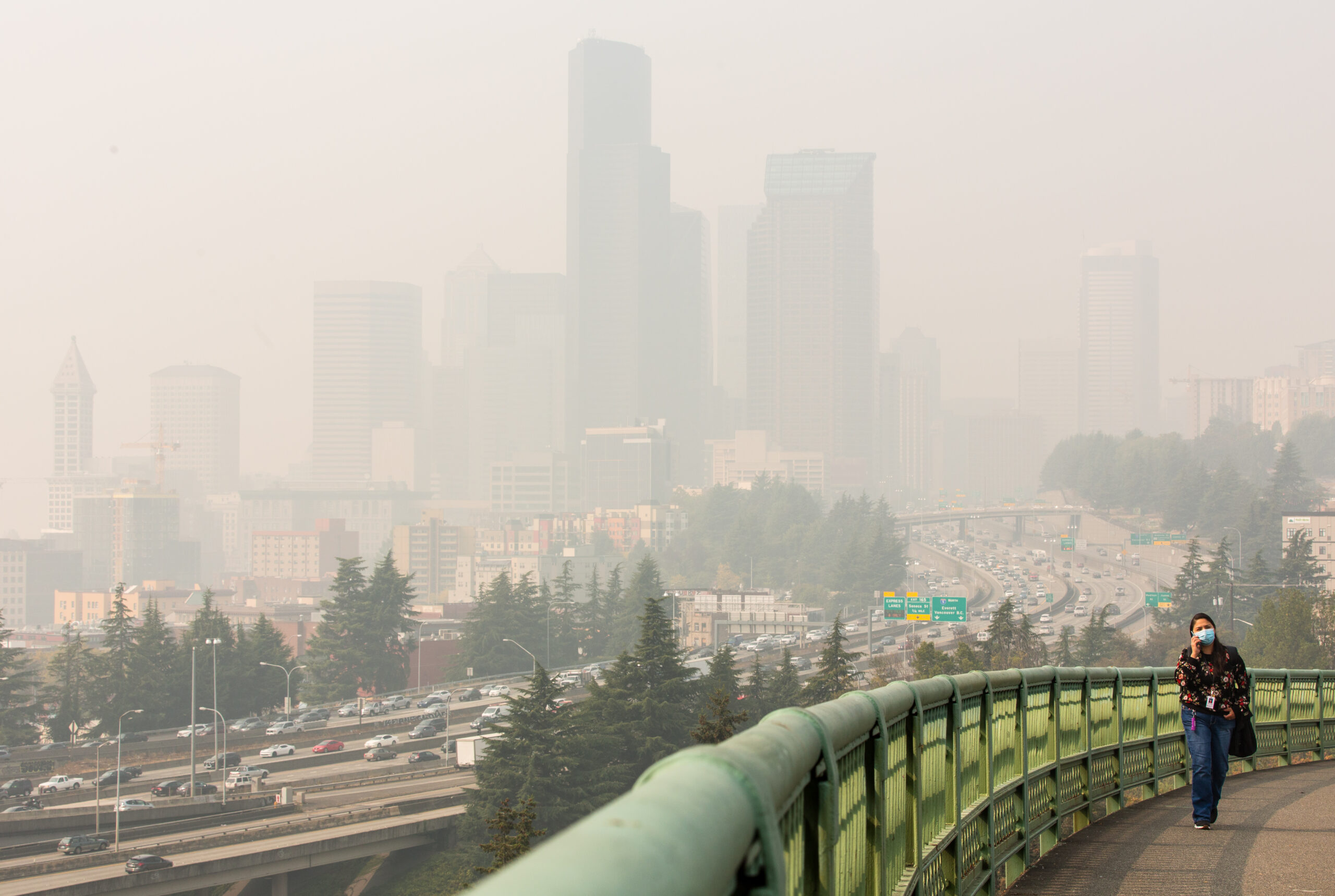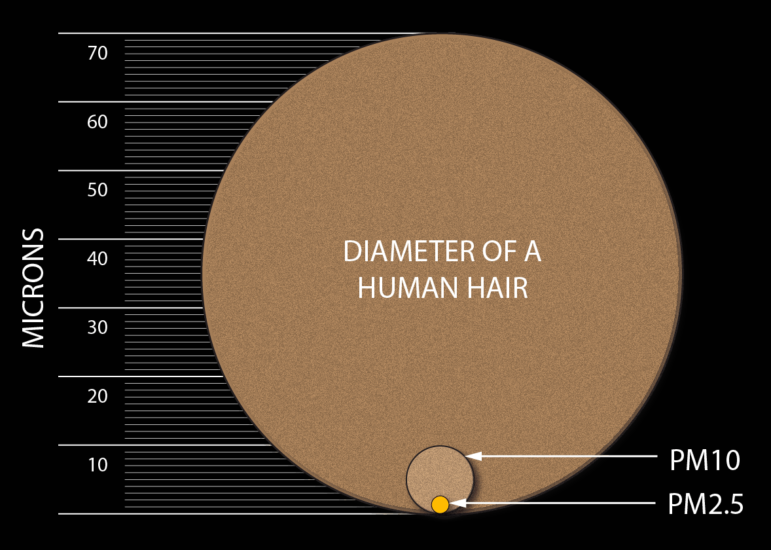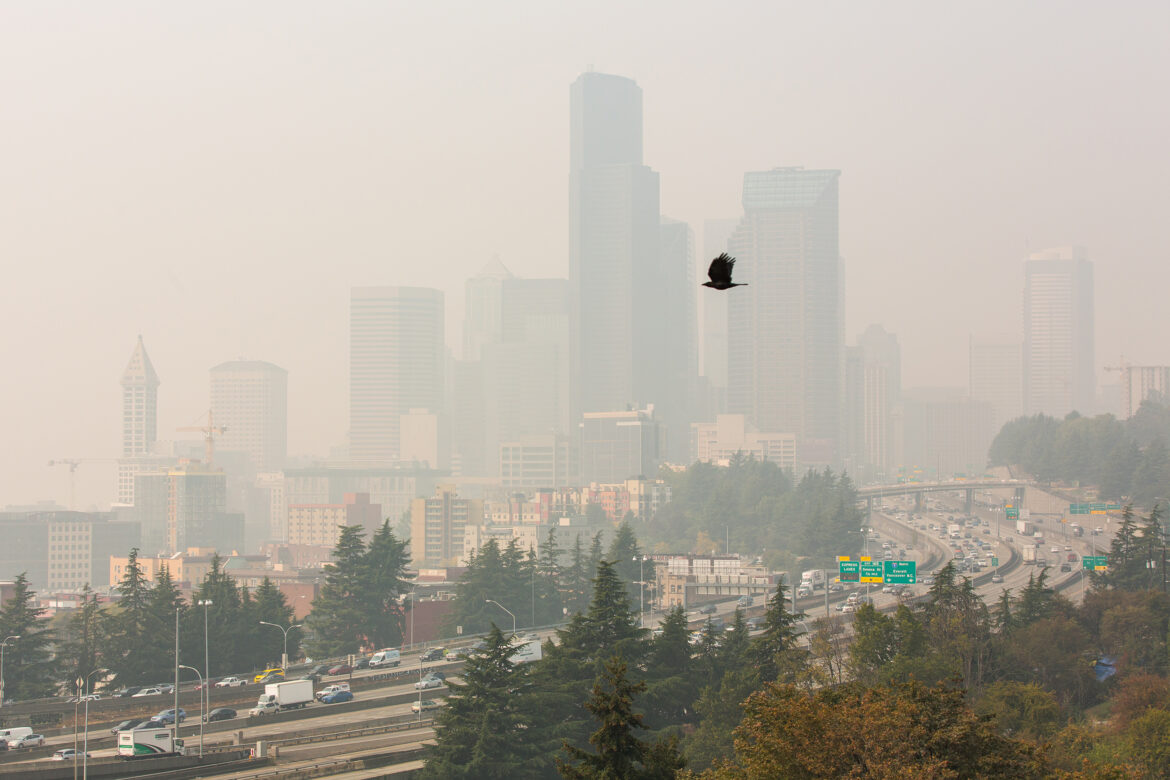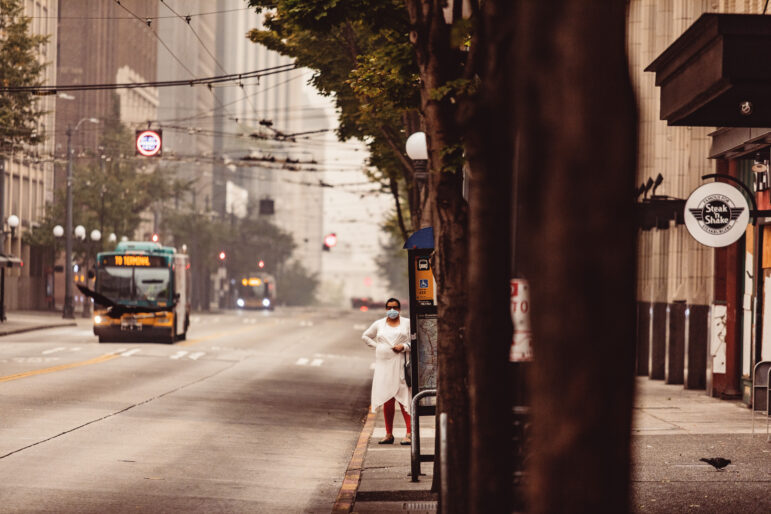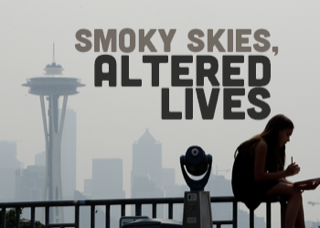
Editor’s note: Wildfires are growing in frequency and intensity, threatening our landscape, our lifestyle and our health. “Smoky Skies, Altered Lives” probes how the upsurge in fire and smoke fueled by climate change puts us at risk, and how restoring the health of our forests could make a difference.
Dan Jaffe did everything he had been told to do. He shut his windows. He stayed indoors. When wildfires burned across Washington two years ago, prompting a state declaration of emergency, Jaffe didn’t run and hike as he liked to during Seattle’s typically gorgeous summers. Instead, he hunkered down, continuing to work as an environmental chemistry professor from his home in Seattle, and sometimes from his desk at the University of Washington Bothell campus.
When he looked outside, he saw a gritty haze. Everything was covered in grey ash. Even indoors, the smell of smoke inundated his nostrils. He couldn’t seem to get away from it.
Jaffe wondered: If a main public health recommendation is to stay inside, why couldn’t he seem to escape smoke? Jaffe conducted an experiment, testing the air quality in his office. It registered at a level that’s unhealthy for sensitive groups such as asthmatics.
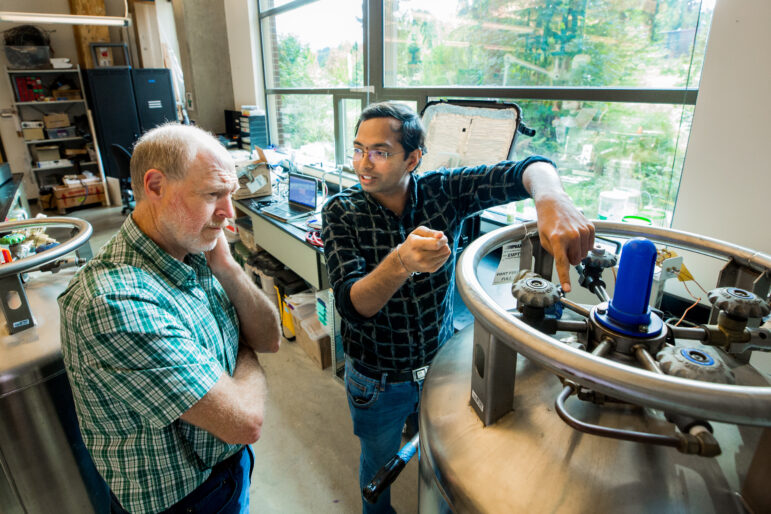
University of Washington smoke researcher Dan Jaffe and post-doctoral research associate Praphulla Chandra Boggarapu discuss equipment used to gather smoke data.
“I started to walk around with a smoke monitor, and realized it was basically the same inside and outside,” Jaffe says.
For years, Jaffe has been studying the composition of wildfire smoke, overseeing a multi-million-dollar, multi-university study to monitor the air on the top of Mt. Bachelor in Oregon. His work is part of a larger, global effort to understand what’s in tiny bits of wildfire ash, and what they can do to human bodies and the environment.
Those tiny, unhealthy bits of soot loom large for our collective health. The massive smoke waves that engulfed the Pacific Northwest this month are likely only a start to a climate-fueled health crisis in the Pacific Northwest of staggering breadth and depth, InvestigateWest found after a year of reporting that involved reviews of dozens of scientific studies, interviews with researchers across the U.S. and Canada, and an independent analysis of a decade’s worth of Seattle hospitalization data.
Research is still ongoing and unprecedented fires are still tearing through the American West. But this much already is clear: Wildfire smoke is dangerous, with evidence mounting that it increases the likelihood of illness and perhaps even death, especially for older people and folks with underlying health conditions. Hazy, orange skies can cause anxiety that lasts years after a smoke event, and may even harm unborn children. And with climate change, more wildfire smoke is coming. But what we’re doing to prepare is inadequate, with poor communities, people of color, and outdoor laborers most vulnerable to dangerous exposure.
“We’re living in a new world,” Washington Gov. Jay Inslee said recently. “This is not the old Washington.”
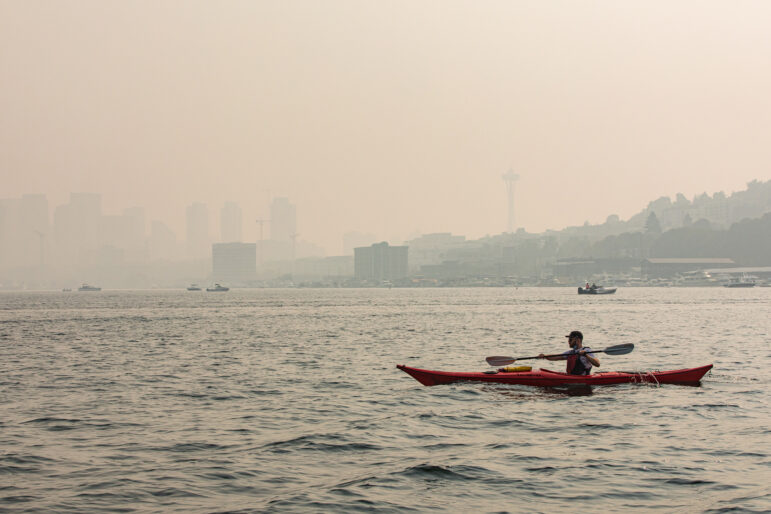
A kayaker paddles across Lake Union through wildfire smoke that obscures the Seattle skyline.
>>>Explore more images from Seattle’s late summer smoke wave.<<<
Nor the old Oregon, which is dealing with what “could be the greatest loss of human life and property due to wildfire in our state’s history,” according to Governor Kate Brown. Or California, which is fighting the largest fire in state history. Or Colorado. Or Montana. Or Alaska. Or a host of other states.
So far this year, wildfires have scorched more than 3.2 million acres of California and all but obliterated whole towns in Oregon and Washington. Dozens are dead and dozens more have been reported missing, with tens of thousands forced to evacuate. California’s Bay Area residents suffered through days where the sun seemingly didn’t rise, blocked by ash, and the pall turned the Pacific Northwest daytimes into twilight.
Without major changes in climate and forestry policy, things will only get worse. As North America faces increasingly long, hot, dry summers because of climate change, the number of deaths attributed to wildfire smoke could double by 2050. Even before the worst effects of climate change are upon us, wildfires are one of the major causes of pollution in America, with California, Washington and Oregon seeing some of the worst air pollution in the world during wildfires in recent years. Evidence is emerging that after a century of misguided fire suppression that has left Western forests hopelessly overstocked, so-called “megafires” that are erupting are increasingly threatening the health of millions of people – as far away as the Midwest, at least.
Put simply, “smoke is bad, it’s getting worse, and climate change is exacerbating fires,” says Sarah Henderson, a senior environmental scientist at the British Columbia Centre for Disease Control in Vancouver, Canada.
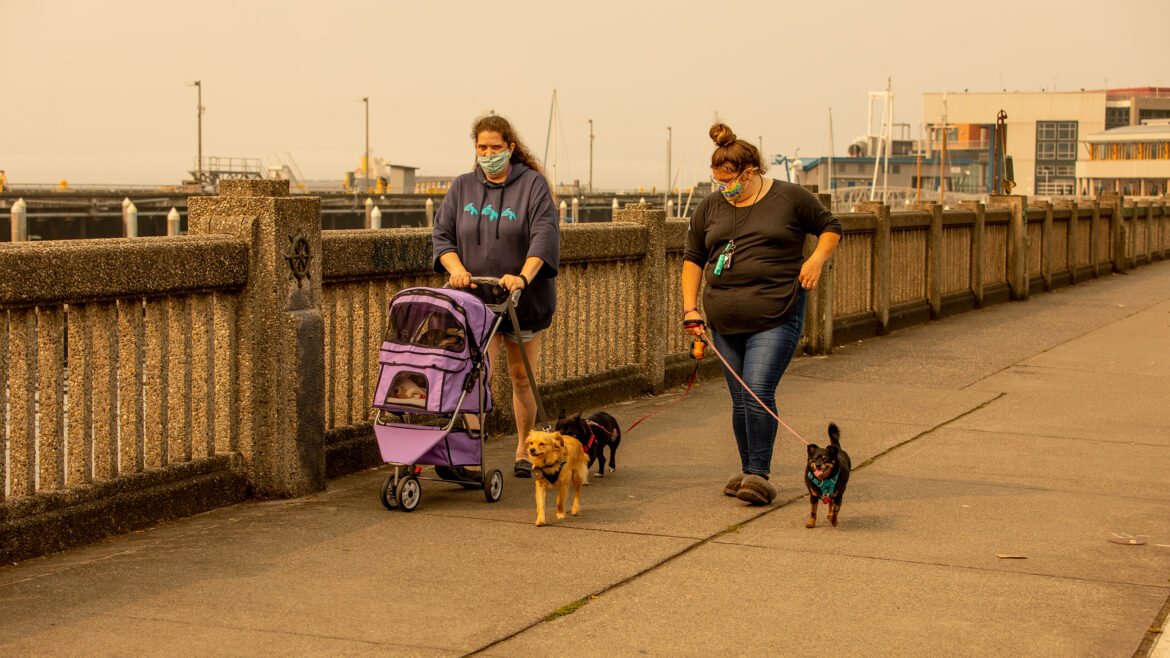
Two women walk their four dogs, three by leash, one by stroller, along Alaskan Way in Seattle during the late-summer smoke incursion.
And yet, government and community efforts to protect the public from wildfire smoke are nascent. Most of the measures suggested by officials rely on individuals protecting themselves: closing windows, wearing N95 masks, staying indoors. But what if being inside isn’t necessarily better? What if someone can’t afford an air filter — or if they work or even live outside? What do we do this year, when N95 masks are saved for essential workers, when most of Seattle’s new “smoke shelters” are closed, and when cafes and day centers the unhoused relied on before have been shuttered for months? Most urgently, what happens when wildfire smoke and coronavirus mix? Should we all become inured to this new inevitability, or is there any way to stop the onslaught of smoke?
Scientists like Jaffe who study the problem say we’re entering an era in the American West. To prepare for the onslaught, we have to start by understanding the magnitude of the crisis.
OUR MICROSCOPIC ENEMY
The air of our modern world is full of small debris from human activities such as driving cars, refining oil, incinerating trash, building skyscrapers and making products in factories. The tiniest bits are classified as PM2.5, meaning particulate matter 2.5 micrometers or smaller. That’s 1/20th of the width of a human hair, or less.
The particles are so small they can slip past the body’s defenses and lodge in the lungs.
Decades of research in some of the world’s most polluted countries — India, China, Nigeria — has shown that exposure to large amounts of PM2.5 can shorten life expectancies by up to two years by causing and exacerbating lung and heart conditions. Exposure to pollution-related PM2.5 is a leading environmental risk factor for early death worldwide.
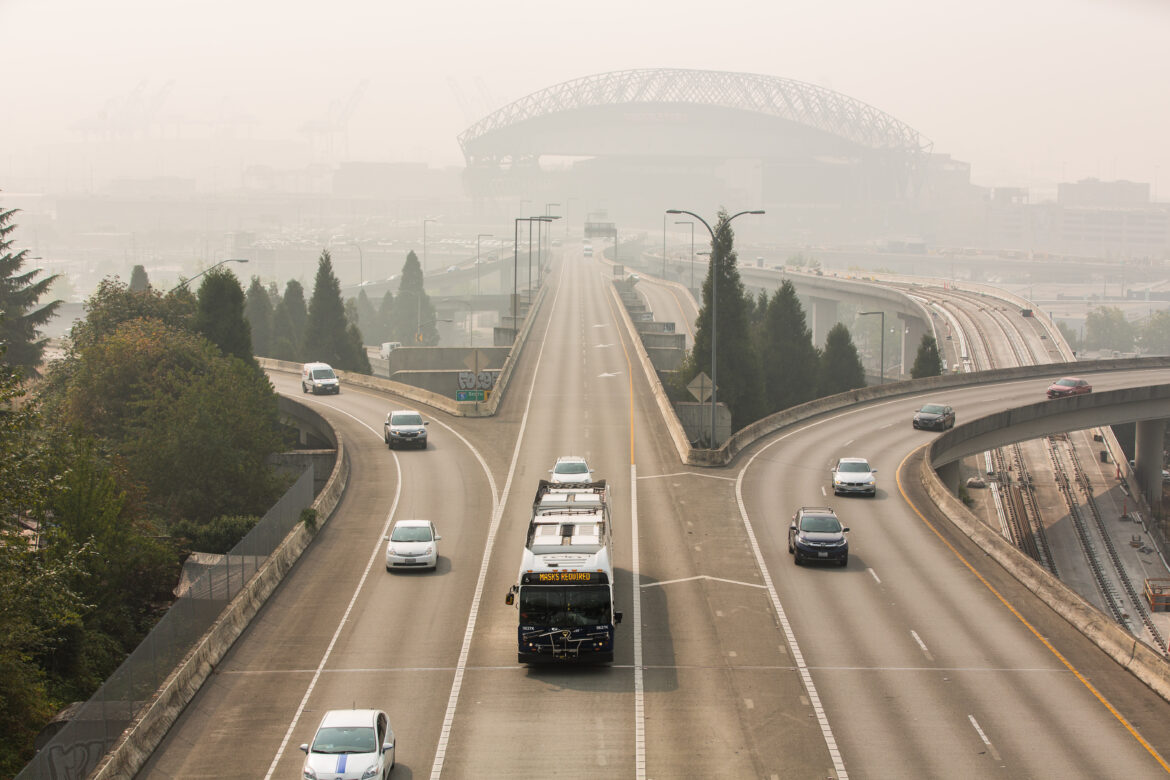
Traffic heads east on I-90 as wildfire smoke obscures the view of T-Mobile Park, the home of the Seattle Mariners.
As wildfires began to become baked into North American summers and falls, researchers asked: If we know that wildfires make these dangerous small particles, too, can we assume they can wreak the same health damage?
Exposure to wildfire smoke can provoke sharp headaches, shortness of breath and other temporary effects — but exposure to PM2.5 means it can also increase the risk of severe respiratory illness, and even death. Some groups are more vulnerable than others: children, whose lungs are still developing; people over the age of 65, whose lungs have weathered a lifetime of wear and tear; and people of all ages with chronic obstructive pulmonary disease (COPD) and asthma.
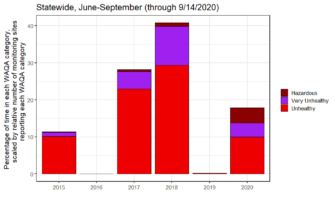
2020’s late-summer smoke wave brought a far higher proportion of extremely dirty smoke classified as “hazardous” compared to smoke waves in earlier years.
One of the scientists who’s been studying the health effects of wildfire smoke the longest is Sarah Henderson, in Vancouver, Canada. Henderson began examining the health effects of wildfire smoke decades ago, as B.C.’s summers became warmer, fire season grew longer and more intense, and smoke regularly filled the air for weeks on end. She tracked asthma patients’ inhaler prescriptions and doctor office visits, showing that asthma and other respiratory illnesses, as well as inner-ear infections, increase during wildfires.
Building on Henderson’s work, dozens of other studies and reports from across the North American West have since shown that wildfire smoke increases trips to the doctor and time spent in hospitals. For example, in Montana in the summer of 2017, hospital admission rates for respiratory complaints doubled over the previous year, according to local officials, and in Oregon in 2013, asthma-related visits to hospitals, doctors and pharmacists in smoke-affected areas were up, especially for those under 15 and over 65.
Video credit: Undark.org
You don’t have to be right next to a wildfire to have a reaction: In August 2018, after weeks of smoke, the Washington State Department of Health noticed an uptick in respiratory-related ER visits for kids and adults across the state, even though fires were concentrated in the east. A review of data by InvestigateWest also confirmed an increase in respiratory-related admissions in Seattle hospitals during smoky years. Wildfire smoke may cause early death, too. A 2020 study tracked mortality over each Washington summer from 2006 to 2017, ultimately concluding that “people of all ages and health backgrounds face a slightly increased risk of dying during and just after exposure to wildfire smoke.” Older adults with underlying lung ailments face the most risk.
“There’s been a small group of us trying to show that this is a growing public health concern for a long time,” says Henderson. “And now everyone is saying, ‘Oh yeah, those guys were right!’”
SO, SMOKE IS BAD FOR US. WHAT CAN WE DO?
As Montana in 2017 faced the worst wildfire year since 1917, Missoula County air quality specialist Sarah Coefield scrambled to support the community amid what she called “apocalyptic” smoke. Public officials had suggested that people evacuate. But even after 35 days of hazardous air, most weren’t budging. To protect the many residents who stayed, Coefield quickly emptied Missoula’s tiny public health emergency preparedness fund, triaging who to give HEPA-supported air purifiers to while finding more cash in order to buy more.
“The governor had declared an emergency and I said, this is an emergency, where’s the money?” recalls Coefield. “Why can’t I give clean air?” Looking back years later, she’s still exasperated. “There is not a mechanism in place to consider wildfire smoke a public health emergency.”
Stuck with few options and seeing hospital admissions rise, Coefield looked to a local nonprofit, Climate Smart, which had already started a small program to deliver air filters to vulnerable seniors the year before. During Montana’s 2017 fires, the organization’s staff made the same realization that UW researcher Jaffe would come to a year later 500 miles away in Seattle: that indoor smoke wasn’t much better than outdoor smoke.
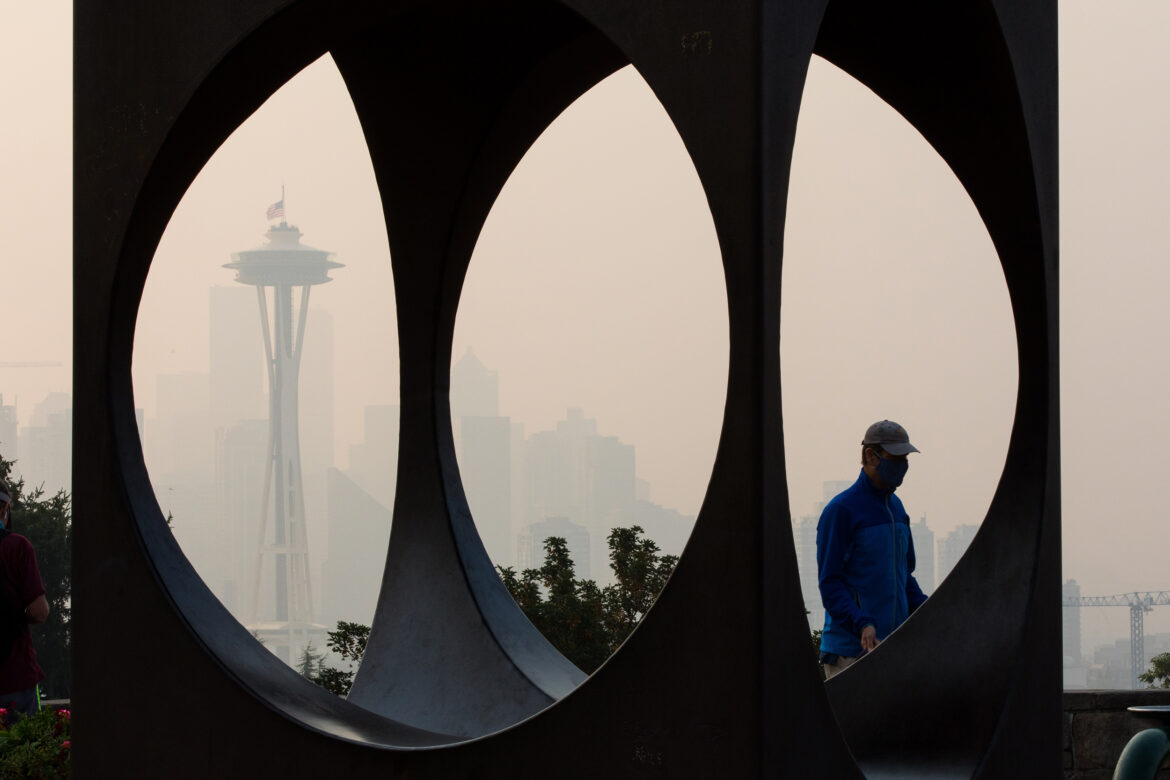
Wildfire smoke obscures the view of the Space Needle and the skyline in a view from Seattle’s Kerry Park.
So Climate Smart’s executive director, Amy Cilimburg, bought more air filters to give away, putting the expenses on her personal credit card in the hopes that someone might one day pay it back. Climate Smart then gave HEPA Portable Air Cleaners, which are mobile and can help to clean indoor air, to homebound seniors with lung troubles, families with newborn babies, health centers and schools. The nonprofit continues to dispense air filters to vulnerable families today, and the United Way eventually covered some of Climate Smart’s costs for the 2017 fire.
Coefield was relieved, and also a little annoyed. Without those extra efforts — Coefield reaching out, Climate Smart stepping up — the Missoula area probably wouldn’t have seen so much support. “I would love for everything to be systematic. It would be great if it was not just one woman in a health department and one woman in a nonprofit trying to do what we can.”
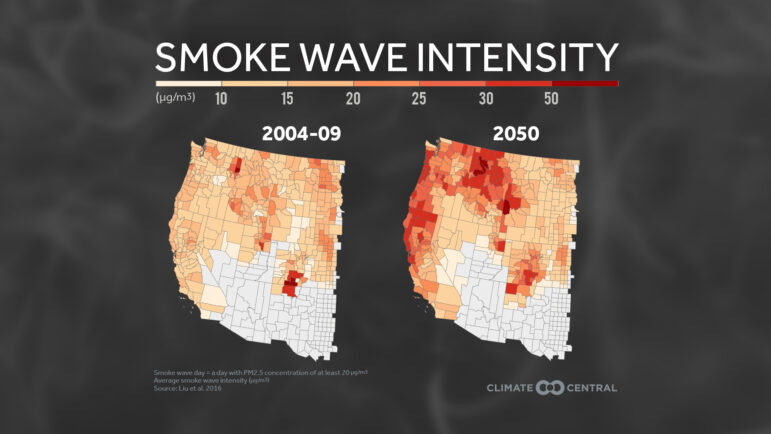
More people are expected to be exposed to wildfire smoke in coming decades as temperatures climb and fire risk increases. A “smoke wave” is defined as two straight days of moderate air quality, or an Air Quality Index of 67. Seattle on several days this month reached worse readings of 150 and higher — meaning “unhealthy” or “very unhealthy,” and other areas of the Pacific Northwest fared even worse.
Coefield expects to be on her own in the future, too. In 2018, her team applied for a post-fire mitigation grant from the Federal Emergency Management Agency, asking to use some of the money to buy air cleaners, purchase air monitors, and write a wildfire smoke mitigation plan. FEMA declined the purchasing of air filters, saying that they didn’t fit their cost-benefit calculation. “That kind of broke my heart, because to me it’s super obvious that clean air is a public health benefit,” says Coefield.
She says she’s been told by FEMA officials that if another wildfire hits, “they’re not going to come to Montana. They told us, essentially, we are on our own, and bootstraps and all, do what you can.” Coefield’s not expecting any help from state officials either. “Our state funding got cut in half a few years ago,” she says, referring to a 42% cut by the Montana Department of Environmental Quality. “We have not asked for more money, perhaps because we don’t expect to get it.”
With already slim budgets tightening, “the question does become, how do we pay for this?” says Coefield. “For what we’re doing, there’s not established funding for this.”
Coefield and Climate Smart successfully fundraised for a stockpile of emergency HEPA filters, with funding from the private Montana Disaster Relief Fund. Some have been given to preschools and day cares, and Coefield has a cache she can pull from to distribute to other hard-hit schools if and when another wildfire occurs. But Coefield’s filters are given on loan, and need to be returned when smoke abates. Her desire is for all public buildings to have updated air filtration systems—”people should be able to expect cleaner air whenever they go”—but outfitting Missoula schools alone would take $150,000, 10 times what Coefield and Climate Smart received from the Disaster Relief Fund. And schools are just a start.
>>>Read: How much smoke is too much? And why comparisons to Beijing are tricky <<<
“We need to help vulnerable and underserved residents,” says Coefield. “I don’t know what to do with unhomed individuals, with people who don’t have a place to go inside, or people who live in a trailer and can’t afford an air filter. That all takes resources.”
CAN LOCAL GOVERNMENTS OFFER A SOLUTION?
In the years since Dan Jaffe tested the air quality in his office, he and his students have worked with the City of Seattle to test different air filtration systems, monitoring indoor air quality to see what can be done to keep air safe. What type of MERV filter is best? What about air curtains? Are expensive systems really better? Can cheap, do-it-yourself attempts work just as well?
Local governments are for the most part figuring these things out on their own. Last year, representatives and senators from Oregon and California—including Vice Presidential contender Kamala Harris—introduced four bills that would provide federal funding to upgrade public buildings and private businesses with clean air systems, establish emergency shelters, require farmworkers to receive N95 masks and education on the health impacts of smoke, and study the public health impacts of wildfire smoke. None have yet passed either the House or the Senate.
In the absence of coordinated federal support, a patchwork of prevention and response activities have arisen across North America. They include Ashland, Oregon, buying air purifiers for vulnerable residents and setting up a “smokewise” website, and Washington state keeping a cache of N95 masks that can be given to the most vulnerable, such as unhoused people (a stockpile that has diminished because of coronavirus). Some organizations are stepping up, too: For example, the Mountain Pacific chapter of the American Lung Association has previously run a program to give air filters to senior citizens with COPD in eastern Washington. (For a look at how Puget Sound communities are preparing for wildfires, check out these resources.)
But most towns used to being caught in wildfire’s crosshairs, such as those in Washington’s Methow Valley, are going it alone, trying to create a rural public health action plan with support from the University of Washington. They complain about limited resources from the state Department of Health, which has no dedicated wildfire smoke program and “no funds available to respond to emergencies – like wildfire smoke events – for local health [departments],” says Elizabeth Coleman, a state spokesperson. (More on the Methow Valley’s response is coming on Wednesday in the second installment of “Smoky Skies, Altered Lives.”)
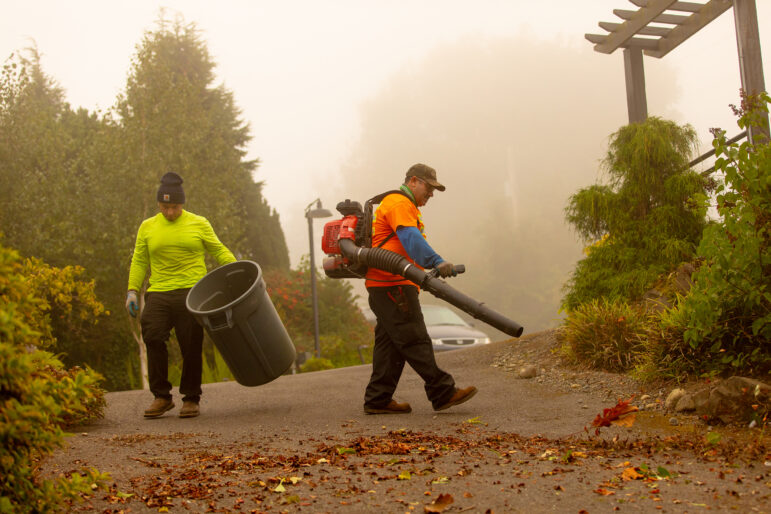
Escardo (left, son) and Conrad (right, father) Martinez owners of Clean Cuts Landscaping, work at a home in Federal Way, Wash.
For the most part, individuals are left to understand and put recommendations into effect when they can. “Our guidance is centered on how to protect yourself, which requires a lot from individuals, so we’re trying to talk early and often with people,” says Julie Fox, with the Washington Department of Health. Last summer, the word was to use N95 masks, which, if fitted properly, can offer some protections. But now they’re supposed to be saved for essential workers. The main advice is for people to stay indoors, close their windows, and wait it out.
But that may not do a lot, as Jaffe’s experiment showed. People who can’t afford to make a clean air space inside — those without HEPA filters or air conditioning, who live in old, porous buildings that easily let smoke inside, or who rely on open windows to keep cool — may be as unsafe indoors as they are outdoors.
>>>Read: Government, employers do little to protect outdoor workers from wildfire smoke<<<
Recognizing that not everyone can re-up their HVAC system, city staff who spoke to InvestigateWest say Seattle has tried to make public spaces safer. Last year, Seattle spent nearly half a million dollars upgrading several city buildings — places like community centers and libraries — with new air filters and air monitors to create “smoke shelters,” while encouraging local businesses to invest in air filters, too. (California has since gone further, establishing a grant program to create “clean air centers” at public buildings like schools, senior centers and libraries in vulnerable communities across the state.)
The idea is that people who don’t have their own clean air space at home — those in precarious housing, the unhoused, those who can’t afford air filtration systems — can pop by a public space for a breath of fresh air. Last year, Seattle also encouraged residents to go to each other’s houses to wait out a smoke event, a way to share clean air and keep isolation at bay.
>>>Read: Racial and economic disparities extend to wildfire smoke, too.<<<
But what seemed like an exciting innovation is now unfeasible during coronavirus, with people told to socially distance and local businesses operating in reduced circumstances if at all. According to Seattle city staffers, some public buildings remain open: a few libraries keep bathrooms available for unhoused people, and two homeless shelters are undergoing air-conditioning upgrades to provide cleaner air. But most of the city’s smoke shelters are closed. One such shelter opened recently in the SoDo district. In the meantime, residents are encouraged to make their own filter with a box fan. (See “How to protect yourself.”)
But it’s not clear smoke shelters are an effective public health solution because they’re “not really an option for low-income people,” explains Anjum Hajat, a University of Washington epidemiologist who researches health disparities.
“If they have jobs they need to keep working to put money on the table, you can’t really go to the day centers and hang out there all day. And if your job happens to be more of an outdoor job, then so be it.”
GOVERNMENT RESPONSE MUTED
Washington state agencies have considered other ways to help low-income people afford changes in their own homes. Public Health – Seattle and King County is partnering with the Puget Sound Clean Air Agency to distribute air filtration kits to some residents, staffer Shirley Tan said — a move Dan Jaffe and his colleagues have previously championed — but she knows that “there’s going to be more of a need than we can provide for.” Some state staffers have floated the idea of encouraging physicians to prescribe HEPA filters, which would mean they could be covered by insurance. (Coefield, in Missoula, thinks governments should go even further and recommend air-conditioning systems as a medical device.)
But those ideas linger in reports and casual conversations. New programs are unlikely to move forward soon, as the same government employees responsible for figuring out how to prepare for and respond to the onslaught of wildfire smoke are now overwhelmed by coronavirus.
Dan Jaffe wants policy makers to realize that proactive action now could help reduce health impacts and long-term costs: “We need to be thinking about how climate change is impacting us, and how we can do these adaptations in advance. Smoke may come, smoke may not come, but we’ve gotta be prepared.”
For Anjum Hajat, an epidemiologist at the University of Washington who studies social and environmental stressors that put marginalized communities at greater health risk, governments need to focus on reaching vulnerable communities. “Maybe it starts with talking to folks about what they need. Maybe that includes partnering with community groups that know the community well and can reach out.”
Jaffe is clear that building smoke shelters and testing air quality is just a start; much bigger changes are needed, right from the top. “Without an international [climate] treaty that America agrees to then there’s no incentive for everyone else to reduce carbon. Without that, these fires are just going to get bigger, more intense, every year.”
This summer, Jaffe’s home and office are inundated with smoke again. With Seattle’s air quality considered unhealthy, he rigged up a simple, do-it-yourself air filter, consisting of a simple box fan and a MERV filter. To his delight, it worked, bringing indoor air quality far into the healthy level. Tucked safely away in what he calls his personal “smoke shelter,” he’s tracking measurements from air monitors he put together at the top of Mt. Bachelor, as the Oregon sky turns grey. “We certainly are having a lot of good smoke events,” he chuckles, before saying that even though it’s good for science, for him and the rest of us, “it’s really challenging.”
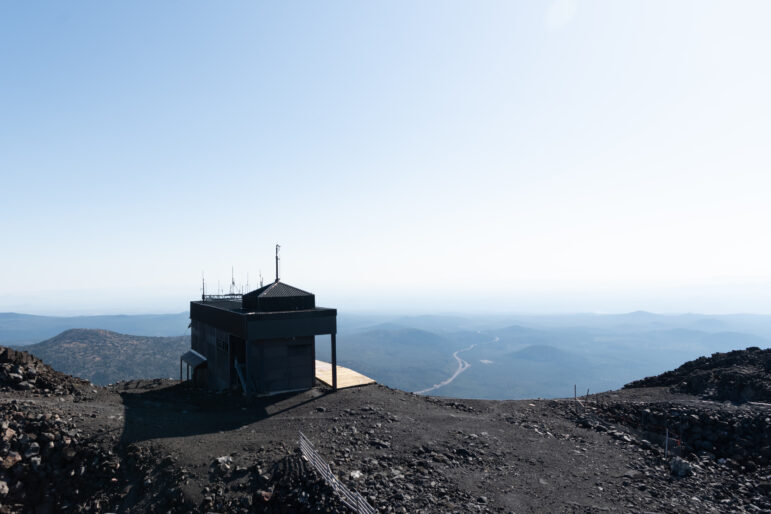
Atop Mount Bachelor in Oregon, inside a building primarily used as a ski lift turnaround, University of Washington scientist Dan Jaffe and colleagues are working on a multi-million-dollar, multi-university study to monitor wildfire smoke. Researchers want to know what’s in wildfire smoke to help understand what tiny bits of ash can do to human bodies and the environment. It’s part of a global research network.
>>>Explore more images from the Mount Bachelor smoke research lab<<<
Jaffe’s persistence to learn more about smoke and what it does to humans and the environment is admirable. And yet even without further studies, without more multi-million-dollar instruments, we know that wildfire smoke risks are making us sick, maybe even killing us, with some of us deemed more disposable than others. The question now is: will cities, states and the federal government act? And will they do so in a way that protects the oldest, the youngest, the sickest, the poorest? Right now, overwhelmed officials are taking the relatively easy route of simply telling people to stay indoors, wear masks, be healthy, and wait it out. Are we prepared to do that, for weeks or months on end?
Sarah Henderson, the British Columbia researcher, worries that after this month’s smoke and wildfires pass, progress will stop. Again.
“The problem with wildfires is everyone is thinking of it when it happens, and then if we don’t have wildfires then we forget about it,” Henderson said. “Human memories are very short.”
Data analysis by Kristen Hwang.

